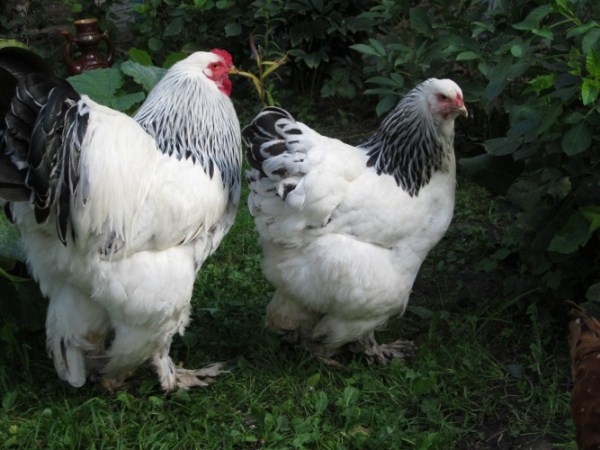Named in honor of the Indian Brahmaputra river, giant chickens with a calm character, aristocratic appearance and high productivity have long been the favorites of poultry farmers all over the world. The article describes the breed of chickens Brahma with a photo.
Table of contents
- Chicken history
- External characteristic of the breed
- Breed assignment
- Weight of hens and roosters
- Temperament
- Egg production
- Species of the Pomfret breed: description and photo
- Breeding and maintenance at home
- Nutrition
- Requirements for the room, video
- Diseases
- The advantages and disadvantages of the breed
- Reviews of poultry farmers and owners
Chicken history
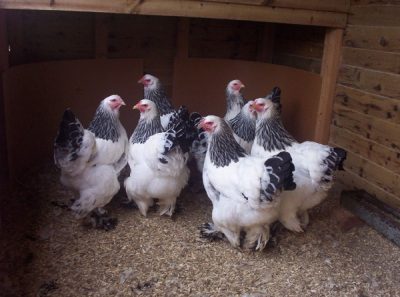 Breed brought the Americans.Conquered by the giant sizes brought in the middle of the 19th century from India, by Asian Asian downy birds, American farmers crossed the gray Cochinmen with fighting Malay and Chittagongs.
Breed brought the Americans.Conquered by the giant sizes brought in the middle of the 19th century from India, by Asian Asian downy birds, American farmers crossed the gray Cochinmen with fighting Malay and Chittagongs.
The breed was called gray chittagong. Her presentation took place in 1850 at the agricultural exhibition in Boston. But, the name did not stick. And as a gift to the Queen of England in 1852, the Boston poultry farmer Barnham presented a bird of this breed, like an ermine chicken of the brahmaputra breed, now known as brahma.
With the light hand of Queen Victoria, the breed spread throughout Europe.
In Russia, according to the results of a survey of the Petrovsky Agricultural Academy, conducted in the early twentieth century, the breed was listed in the top five most common birds on farmsteads. Orpingtons, Cochinquins, faerolis, Plymouths, and American Brahms were in favor.
External characteristic of the breed
The appearance of chickens brahma (braminka, brahmins) in the catalogs is described by standard features:
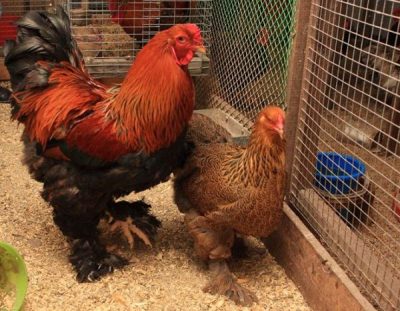
- Color different color. The plumage is silvery-white, gray, brown, partridge, black.
- There are colored varieties: yellow, blue, striped, white-blue and red Colombian colors, black or blue with white splashes (birch), fawn.
- Pooh ashen, plentiful. Feathers are soft, adjacent to the body, not loose. Roosters must have a contrast gate. Tail in the form of a fan, lush.
- Leather yellow shade.
- Head small size. The forehead is wide. Three-row pod-shaped (pea-shaped) comb without clearly distinguished teeth.
- Constitution dense, fleshy. Chest, back, abdomen, wide ass. High landing body. Differs from related kokhinhinov higher tail lift, thin bones. Chickens are more rounded and have shorter legs than roosters.
- Wings developed. Legs powerful, long, fully feathered, including external and middle toes. Fingers and metatholes are strong, yellow, greyish in dark frames.
- Length neck medium, with a bulk mane in the upper part, with a slight bend.
- Beak yellow, strong.
- Eyes orange, bright, deep-lying. Brow arc high, overhanging.
- Earrings and earlobes red, small, medium long. Skin fold (bridle) on the neck under the beak.
Breed assignment
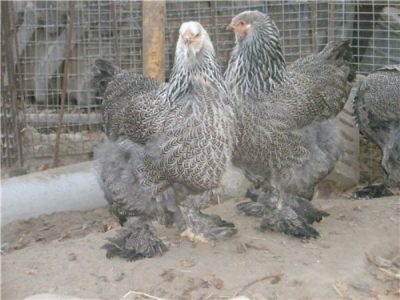 Initially referred to the meat direction. Now positioned as a decorative and meat. The decline in the breeding qualities of the breed was due to mixing with other species (Cochinquans, Asian species), closely related breeding, and a preference for productive decorative qualities. Brahmin meat is considered the most tender, dietary, quality among all meat breeds and crosses. With the wrong selection of food, additives, meat coarsens, deteriorating its taste.
Initially referred to the meat direction. Now positioned as a decorative and meat. The decline in the breeding qualities of the breed was due to mixing with other species (Cochinquans, Asian species), closely related breeding, and a preference for productive decorative qualities. Brahmin meat is considered the most tender, dietary, quality among all meat breeds and crosses. With the wrong selection of food, additives, meat coarsens, deteriorating its taste.
Currently divorced mainly in individual farms, in small farms, amateur collectors, with their reviews can be found below. For modern poultry farms of no interest.
Weight of hens and roosters
The live weight of laying hens is 3.5-4 kg, roosters - 4.5-5 kg. In the heyday of the breed there were birds weighing more than 7 kg. Today, these giants are almost impossible to meet.
Temperament
The main characteristic of the Pomraham hens is endurance, unpretentiousness and resilience. They need a small chicken coop, a small walk.They have a wonderful character - calm, even phlegmatic.
Egg production
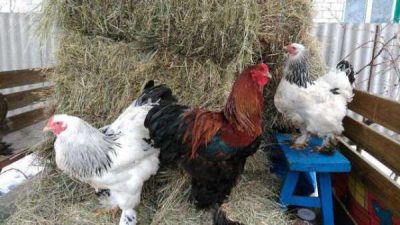 For meat breed is considered average. Brahmins carry 100-120 eggs per year, weighing about 50-65 g. The shell is strong, various shades of brown-brown, cream-colored. In winter, the number of eggs does not fall. Young chickens of early hatching become 9 layers after 9 months.
For meat breed is considered average. Brahmins carry 100-120 eggs per year, weighing about 50-65 g. The shell is strong, various shades of brown-brown, cream-colored. In winter, the number of eggs does not fall. Young chickens of early hatching become 9 layers after 9 months.
The daily optimal amount of feed for the formation of eggs weighing 60 g - 110-150 g. The average cost of feed per egg - 30-40 kopecks.
Species of the Pomfret breed: description and photo
Since the end of XIX century, derived The main varieties of Pomrama chickens are: American meat, decorative and meat Asian, decorative European, decorative dwarf. There are also subspecies: light, dark, crooked, fawn.
Kuropatchataya
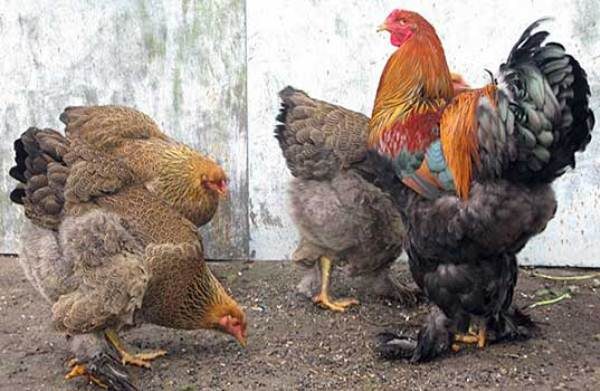
American meat subspecies. By color it looks like a partridge, hence the name. The plumage is brown with a golden hue; the black tail is cast in metallic green glitter.
Fawn (buff)
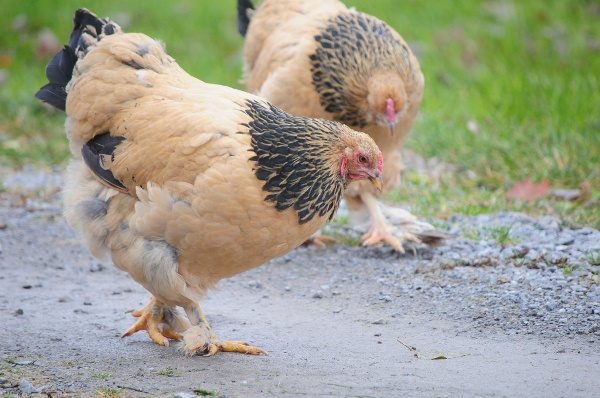
Golden brown plumage, the edge of the neck and tail are black. In roosters, the mane is darker than the main color. Easily tolerates a cold climate.
Light
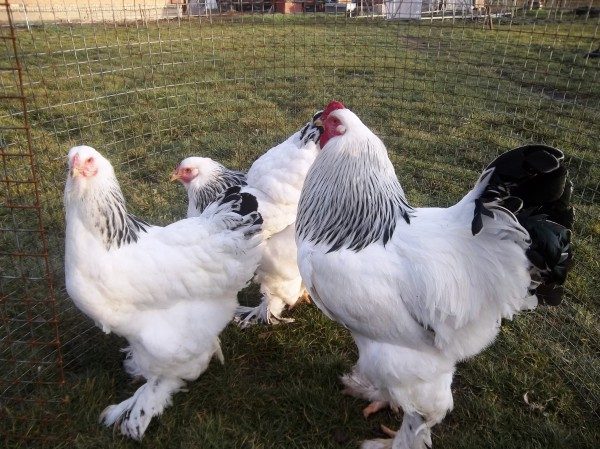
Colombian silver gray color. Tail tail feathers, wing wings, gate at the neck of a rich black and green color. The middle feather on the fingers and metatarsus has black stripes. In chickens on the belt white feathers, roosters flaunt black. Comb, face, earlobes bright red. Due to the lush plumage of the body, legs and neck, beautiful appearance, smooth face, large eyes and beak have an extremely decorative look.
Dark
Most birds are gray with a white, silver head. White feathers on the neck with black edging, sickle-shaped on the body, gray to black, parallel to the contour, stripes. The structure of plumage is friable, abundant. Roosters have silver-gray head, mane and neck silver-white with black central stripe. At the feet of the hawk shred - lush feathers on the legs. The main plumage is greenish black. The skin is white with pink. Paws are yellow. Brown eyes with a reddish tinge. The distinctive feature is a short curved beak, yellow with black stripes. Straight, small tail.
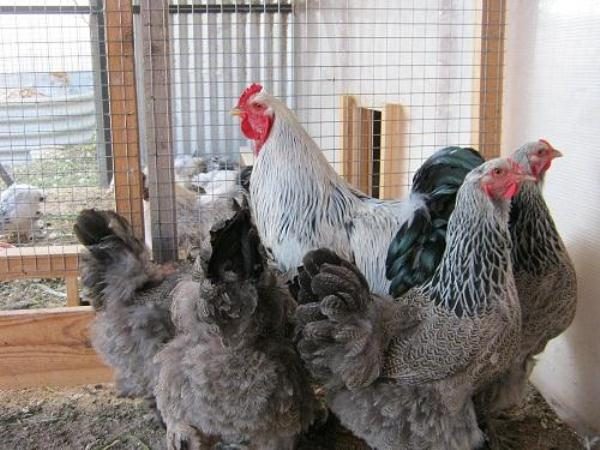
Appreciated for good preservation. Survives up to 68% of chickens, up to 83% of adult individuals. Dark brams are nice hens. Undemanding conditions feed, get along with other breeds.
Breeding and maintenance at home
It starts with the purchase of adult birds, young or selection of eggs. Owners of individual poultry houses can purchase chickens from breeders. The price for chicks age 7-15 days is quite high - 300-350 rubles, and the price of adult birds reaches 3,000 rubles. Eggs for an incubator cost from 60 to 200 rubles apiece.
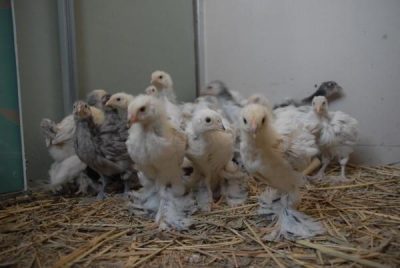 It is better to transfer the eggs selected in the household for transferring to the nests of smaller breeds or to place them in an incubator. Brahms have a developed incubation instinct, but due to the heavy weight they can crush up to a quarter of eggs. It is safer to remove the brahmins in the incubator.
It is better to transfer the eggs selected in the household for transferring to the nests of smaller breeds or to place them in an incubator. Brahms have a developed incubation instinct, but due to the heavy weight they can crush up to a quarter of eggs. It is safer to remove the brahmins in the incubator.
Juveniles are characterized by slow growth, hatched later than June can not overwinter.
Adults purchased chickens at the time placed in quarantine. Chicks from 4 months of age are recommended to be kept separately from adult chickens and young stock of other breeds.
Nutrition
Feed Requirements common for young animals, adult chickens and laying hens:
- Feed must be fresh
- Feed must contain a sufficient amount minerals, vitamins, microelements, calcium. Achieve this using food waste, Zelenka from the garden, grain and specialized industrial additives, shell powder, chalk or eggshell.
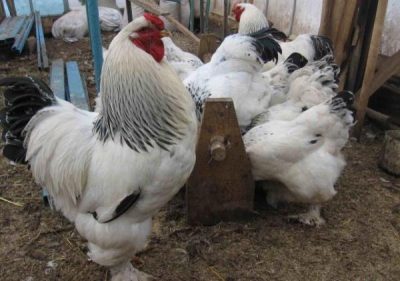 To activate the work of the gastrointestinal tract in a separate container with high sides pour river sand or small gravel.
To activate the work of the gastrointestinal tract in a separate container with high sides pour river sand or small gravel.- Stick to three meals a day. Brahmas easily learn to eat from their hands, and receive food at the same time.
- Experienced poultry farmers recommend stick to the scheme: 1st feeding - cereal mixtures, 2nd - a variety of mixers moistened with water or broth with the addition of food waste, greens, 3rd e - grain.
- Follow drinking regime. Water at room temperature is poured into disinfected drinking bowls at the rate of 1.8 parts of water per one part of any dry food.
- For motor activity, about 10% of the grain in winter is poured on the litter, portions of feed increase.
Gadfly chicks are lively, active. Up to 6-7 months, they need enhanced balanced nutrition. The first weeks give finely grated boiled eggs mixed with finely ground corn or wheat grits.
From the second week, low-fat cottage cheese with chopped green nettle, knotweed or dandelion is introduced into the diet.Then begin to add the tops or roots of carrots, beets, cucumbers, apples, zucchini.
Daily diet for the adult meat frame and layer, the composition is almost the same: 50-55 g of grain, 30 g of wet mash, 100 g of boiled potatoes, 10 g of hay flour, 3 g of chalk, 2 g of bone meal, 0.5 g of salt. If the chicken is grown for meat, the daily rate of grain is increased.
Requirements for the room, video
The coop should be spacious, dry, with good ventilation, a description of which can be viewed below. Frames are heavy birds, therefore, the roost is made of a die not less than 30 cm wide, which is nailed to a wall at a height of 40-50 cm.
In our climatic conditions, additional artificial lighting is required.
Diseases
Although the chickens of this breed are considered unpretentious, but they are susceptible to disease.
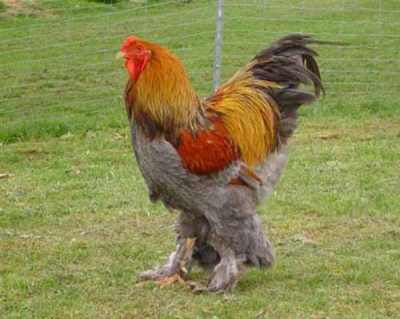 One of the conditions for growing at home is strict hygiene. Drinkers, perches, feeders, bedding should be regularly processed. In order to relieve the plumage of Brahmans from parasites, ash, ashes are added to the litter.At least once a quarter, do antiparasitic foot baths. For this purpose, birch tar or sunflower unrefined oil is poured into a suitable dish for one third.
One of the conditions for growing at home is strict hygiene. Drinkers, perches, feeders, bedding should be regularly processed. In order to relieve the plumage of Brahmans from parasites, ash, ashes are added to the litter.At least once a quarter, do antiparasitic foot baths. For this purpose, birch tar or sunflower unrefined oil is poured into a suitable dish for one third.
Young animals are vaccinated against bird flu. Protect from drafts. As a prophylactic against rickets, chickens are given boneless fish waste or fish oil once a week.
The advantages and disadvantages of the breed
The advantages include meat productivity, resilience, unpretentiousness to weather conditions, the area of content, decorative.
Disadvantages: the high cost of material for growing, low mobility of chickens, a long period before the onset of egg production.
Reviews of poultry farmers and owners
Growing very slowly, the breed is not cheap and very often you may slip a cross between a hedgehog and a rhinoceros.
Keep a pale and light breed. Honestly very hard breed for breeding, then the nerves are necessary. I took 18 chickens in the spring with a daily allowance of 18 heads for a trial, they really liked it in appearance. All grew up without a case, except for two of their own hunting dog, crushed at the age of one month by mistake. Grow very slowly. The first egg thought I can not wait and I will cut off their heads.In general, when they were one month old, my simple Siberian layer brought out chickens that were already rushing, and at the gangbang only scallops were identified at that time. But! Grown beauties to fame. One of the most sickly, but voracious slashed at trial. Meat did not like. Part sold, and I will say that it is very profitable. Torn off their feet, as they say, justified their price. He left the most powerful and beautiful.
Brama is now a purely decorative breed, there are few eggs from them, meat too. The chicken is most productive in the first 2 years of life, hens carry eggs, according to my observations, up to 4-5 years, then it makes no sense to keep the bird. We had no problems with chickens from these chickens, the only thing is that chickens are prone to obesity (if fed improperly, they become fat, and almost do not carry an egg).
Almost tame, unpretentious chickens are not only the decoration of the yard. Armed with patience, you will soon get a source of dietary eggs and meat with excellent taste to your table.
